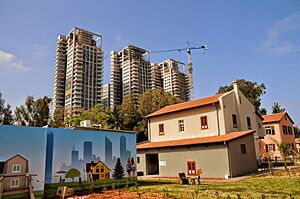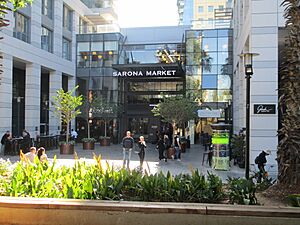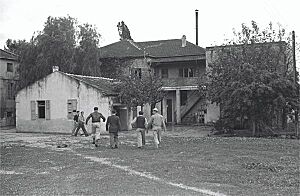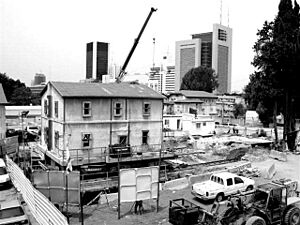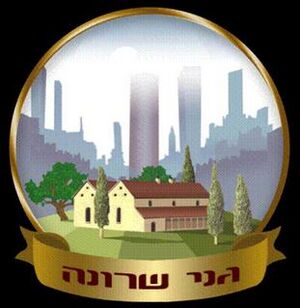Sarona (colony) facts for kids
Sarona is a neighborhood in Tel Aviv, Israel. It started as a special village built by a group of German Christians called the Templers in 1871. It was one of the first modern villages built by Europeans in Palestine a long time ago.
In July 1941, during World War II, the British government, which was in charge of Palestine at the time, sent away 188 people from Sarona. These people were believed to support the Nazi party. By the early 2000s, the area looked old and run down. But since 2003, Sarona has been beautifully restored. This involved moving some old buildings to new spots before fixing them up. Today, Sarona is a popular place for shopping and has museums and historical displays. It also has buildings used by the Israeli army.
Contents
History of Sarona
In August 1871, the Templers bought a large piece of land. It was 60 hectares (about 150 acres) from a Greek monastery. This land was north of Jaffa, near the Yarkon River. In October 1871, they started building their first houses.
The first few years were very hard. Many settlers got sick and died from diseases like Malaria. In 1872 alone, 28 out of 125 settlers died. To help dry out the swampy land, they planted 1,300 eucalyptus trees.
By 1889, 269 people lived in Sarona. They had 41 homes, a community hall, a place to make wine, workshops, and barns. The Templers brought new farming tools and methods to the area. They focused on growing crops and making products they could sell. This was new because, for centuries, people in the area only farmed enough for themselves. They started with grain crops and dairy products. Later, they planted fruit trees and vineyards.
In 1895, the colony had seven gardens. Workers were hired to take care of them. A large winery opened, and they sold their wines in Germany. As their dairy farm grew, they sold milk, cheese, butter, and meat in Jaffa. When other Jewish wineries started to compete, the Sarona colonists changed their vineyards to grow citrus fruits instead.
The community needed money to build roads and other things. So, they started a system called Frondienst. This meant every man had to do a certain number of hours of community work each month. This helped them build roads, improve the land, and create community buildings. A traveler named Sven Hedin visited Sarona in 1916. He wrote that many plants were blooming. He also noted that they mainly grew grapes, oranges, and vegetables. They also produced milk and honey, just like in old times.
Sarona During British Rule
In November 1917, British soldiers took over Sarona. They used the community house as a hospital and took over other buildings for military use. In July 1918, the British sent all 850 Templers to a camp in Egypt.
After some help from groups like the Red Cross, many Templers were allowed to return to Germany. On July 29, 1920, the remaining Templers were allowed to return to Palestine. When they came back, their colony had been robbed and damaged. After talking with the British, they received some money to help fix things.
A count of the population in 1922 showed 279 people living in Sarona. This included Christians, Muslims, and a few Jews.
By 1925, Sarona was still small but had grown. It was still a farming village, but people were also doing more trade. Many Jewish immigrants came to Palestine between 1920 and 1926. This created a good market for Sarona's products and services, and the settlement became more successful. By 1931, Sarona's population had grown to 564 people living in 104 houses.
World War II and Changes
When the Nazis came to power in Germany, all German schools around the world had to change their lessons. They also had to hire teachers who supported the Nazi party. The swastika symbol was used in these schools.
All Germans living in Palestine were held by the British in special camps. Sarona held almost 1,000 people behind a tall barbed-wire fence. In July 1941, 188 people from Sarona were sent to Australia. They stayed in a camp there until 1947.
Jewish underground groups were worried that the German Templers might stay in Palestine. They wanted them to leave. On May 16, 1943, the Sarona community hall was bombed by the Irgun, a Jewish underground group. Six people were hurt.
On November 25, 1943, Sarona became part of the Tel Aviv Municipality. By November 1944, most of the remaining Sarona residents had been moved to another camp. The last group was sent there in September 1945.
After the War
In November 1947, the British government said that Templer land in Palestine was "enemy property." A few months later, the Tel Aviv municipality bought a large amount of land in Sarona from the British. Three weeks before Israel became an independent country, the British sent the remaining Templers to Germany and Australia.
Sarona in Israel
In 1948, when the British left and Israel was founded, the old houses and army buildings in Sarona were used by the new Israeli government as offices. This area became known as the "Kirya." Part of it became a military area. This included the Israeli Ministry of Defense and the main offices of the Israeli army. Other parts of old Sarona were used for other government offices.
In 1962, the State of Israel paid money to the Templer property owners. This was to make up for their land being taken by the government.
As Tel Aviv grew quickly, the Kirya became a very valuable area in the city center. In the mid-1970s, there were plans to rebuild the area. But people who wanted to protect old buildings fought against tearing them down. After talking with historians, it was decided that Sarona was important for its history and architecture. So, 18 buildings with special designs were chosen to be saved.
Government offices moved out of Sarona's low buildings. They moved into a tall office building built at the east end of the area. When Kaplan Street, Sarona's main road, was made wider, a lot of effort was made to move the historic buildings without damaging them. These buildings then became an area with cafés, shops, and places for fun. A tall headquarters building was also built in the military section. However, historic buildings in that area are still used by the Israeli army.
Sarona's Restoration
In 2003, the Tel Aviv municipality started a project to save and restore the historic buildings in Sarona. To make space for a new highway, special methods were created to move some of the houses to a better spot.
Some of the houses chosen for preservation included the original Community House, the Old Lämmle House, and the New School.
In 2008, after Kaplan Street was made wider, four houses and the old community house were moved. The area to the south was then renamed Ganei Sarona (Sarona Gardens).
One of the most important buildings in Sarona was the community house, called Gemeindehaus in German. Its first stone was laid in 1871. The building was finished in early 1873 and held the local school. When Sarona became a place where Nazis had influence, the swastika flag flew over this building for seven years. In 1943, fighters from the Irgun group placed a bomb near the building. Six people were slightly hurt, including Gotthilf Wagner, who was the mayor of Sarona and a strong Nazi supporter. When the British left Tel Aviv in 1947, an Israeli defense group camped there. The building was renamed after Carmi Rabinowitz, a commander who was killed in action. In July 1948, after Israel was founded, it became a post office.
During the restoration work in 2005, the old iron parts of a clock were found. This clock used to be on the front of the building. In 2006, the clock was shown at the Eretz Israel Museum as part of an exhibit about the Templers. A descendant of the Templers who was visiting Israel recognized the name of the company that made the clock. After contacting the company in Germany, a new clock was made to replace the old one. The original, now fixed, is shown at Sarona's visitor center.
Sarona's Legacy
Helmut Glenk, who was born in Sarona, has written several books about the area. These books explore how the Templers helped modernize Palestine.
See also
 In Spanish: Sarona para niños
In Spanish: Sarona para niños


